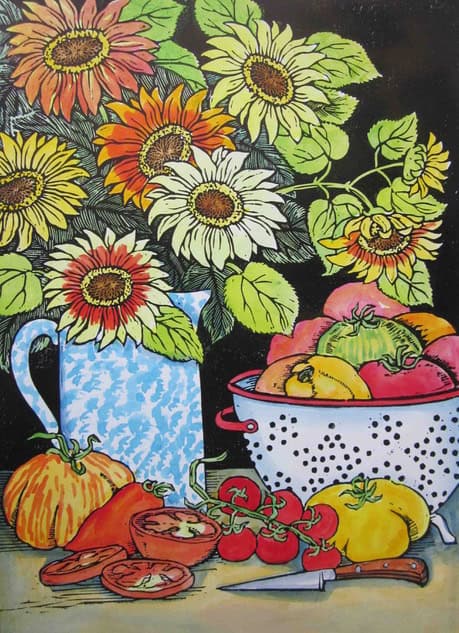About the Salad Lovers Garden
Scroll down for a free garden design and planting guide, plus 10 tips for successful growing. A series of small beds provide easy successive planting that will keep a steady supply of greens from seed to salad bowl.

A Salad Lover’s Garden can be as small as a perfect one-square-foot plot, or a matrix of geometric designs. For new gardeners, lettuce and salad greens are the easiest and quickest garden crops to grow and are ideal to plant in a kitchen garden. Consider a full range of European and American heirloom greens blended with gorgeous lettuces that weave together into a colorful tapestry almost too beautiful to harvest.
A garden of salad greens, either wild or cultivated, is rich in vitamins and minerals, and can contain as many as 50 different plants with flavors from buttery-soft head lettuce to piquant arugula and peppery cress. You can also grow salad onions, radishes, carrots, salad cucumbers, and a range of edible flowers to enhance the salad bowl, but in this design, salad greens steal the show with their unique blend of wild colors, textures, and shapes.
Since greens enjoy the cooler weather of early spring and late fall, start the season as early as you can work the soil. Plan to grow tender cutting lettuce and arugula, and then branch out to include a variety of peppery mustards, spiky cress, and ornamental kale. Lesser known yet equally piquant is cress (unrelated to watercress), which packs a spicy wallop in its raw form, with tender ferny leaves that are finely chopped and blended to season classic French vinaigrette.
Design below is a excerpted from my book, The Complete Kitchen Garden. For a Free PDF planting guide to go with this design, follow this link: Salad Lovers Design w.Planting Guide. My favorite resource for the freshest seed and a unique range of colors and flavors is Wild Garden Seed.
 Here are Ten Tips for Growing a Salad Lovers Garden
Here are Ten Tips for Growing a Salad Lovers Garden
- Consider the benefits of raised beds to keep the beds tidy and neat. They can be as low as 6 inches or as tall as 3 feet, depending on your preference.
- If you have a nearby hose, install a convenient drip irrigation to provide a constant, steady flow of water during the season, which salad greens prefer. Lettuce and salad greens are 80 percent water, so be sure to keep the plants moist, as needed.
- Greens love cool weather, so take advantage of the spring and fall seasons to plant a crop of greens. Prepare your garden with soil that is rich in nitrogen, which feeds and supports leafy green plants. Add compost or aged bagged manure as a good source of vitamin-rich nitrogen, and till into your soil with a garden fork before sowing seeds.
- Most lettuce and salad greens will grow easily from seed, so plan to direct sow your seeds. Sow the seed 1/2 inch in the ground, tamp the soil, and mark the spot with a stick or plant tag. Plant successively every two weeks throughout the growing season.
- Many greens are “cut-and-come-again,” giving you several harvests from one sowing. Clip the leaves just above the roots. Water well, and new greens will sprout for another salad in a few weeks.
- Combine various shapes and colors to add visual delight to a tasty salad. Plan to include spikes of color, and variegated leaves to break up the mostly green hue of the lettuce.
- Some greens grow fast; others, such as mache, are slower to germinate, so be patient. The unique rounded, cup-shaped leaves of this mild-tasting green offer a striking contrast to a bowl of greens and are well worth the wait.
- Flea beetles are one of the few pests that affect salad greens (other than rabbits) and they can leave your greens with small holes. To prevent flea beetle damage, cover your greens immediately with a floating row cover or Reemay fabric after planting.
- At the end of the season, plant a cover crop of buckwheat or annual rye grass to keep building the nitrogen in your soil, essential for healthy greens.
- Harvest salad greens with scissors, just above the root line. For clean greens, harvest before a rainstorm to prevent splatter from soil. Salad spinners makes washing and drying greens easy, and then wrap the washed greens in a paper towel prior to serving to absorb excess moisture.


